
Bennie Luke Davis was a United States Air Force general who served as the commander-in-chief of Strategic Air Command, and as the director of Joint Strategic Target Planning Staff, with its headquarters at Offutt Air Force Base, Nebraska. The command was the major American nuclear deterrent force with bombers, tankers, reconnaissance aircraft and intercontinental ballistic missiles. The Joint Strategic Target Planning Staff coordinated United States nuclear war plans and develops the Single Integrated Operational Plan.
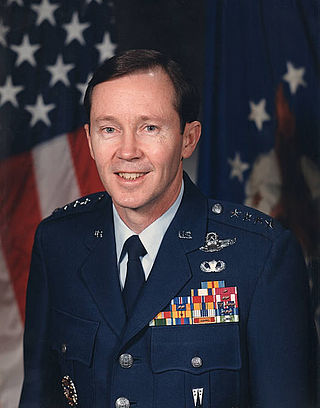
George Lee Butler, sometimes known as Lee Butler, is an American retired military officer. He was commander in chief, United States Strategic Command, and the last commander of Strategic Air Command. Following his retirement from the military he became active in the nuclear disarmament movement, calling for the outright abolition of nuclear weapons.
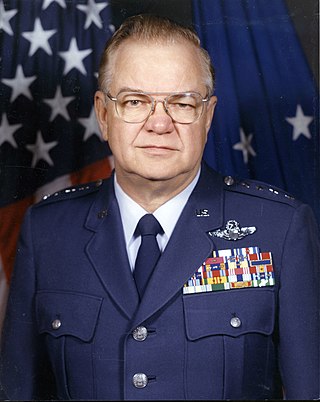
William Leslie Kirk was a four-star general in the United States Air Force (USAF). He served as Commander in Chief, United States Air Forces in Europe/Commander, Allied Air Forces Central Europe (CINCUSAFE/COMAAFCE) from 1987 to 1989.

James P. Mullins is a retired United States Air Force four-star general who served as Commander, Air Force Logistics Command (COMAFLC) from 1981 to 1984.
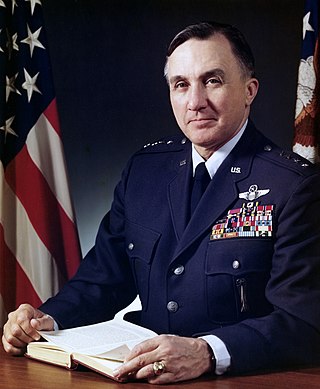
Bryce Poe II was a United States Air Force four-star general who served as Commander, Air Force Logistics Command (COMAFLC) from 1978 to 1981.
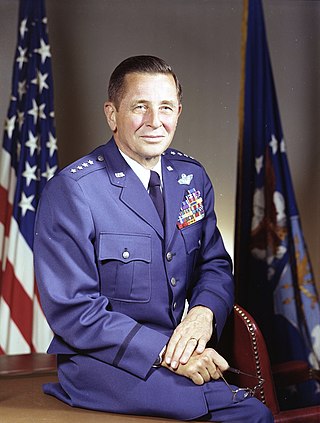
General Robert James Dixon was a four-star general and Command Pilot in the United States Air Force (USAF) who served as Commander, Tactical Air Command (COMTAC) from 1973 to 1978. He also served simultaneously as commander in chief of U.S. Air Forces for both the U.S. Atlantic Command and U.S. Readiness Command.
Leslie J. Westberg was a brigadier general in the United States Air Force. He piloted bombers on combat missions in both World War II and the Korean War and reconnaissance aircraft in the Vietnam War.

Thomas Martin Ryan Jr. is a retired United States Air Force general who served as the commander of Air Training Command (COMATC) from 1981 to 1983 and as Commander in Chief of the Military Airlift Command (CINCMAC) from 1983 to 1985.

Earl Terrence O'Loughlin was a general and commander of the Air Force Logistics Command, with headquarters at Wright-Patterson Air Force Base, Ohio.

Robert Dale Russ was a United States Air Force (USAF) general and commander of Tactical Air Command.

Monroe W. Hatch Jr. is a retired four-star general in the United States Air Force (USAF) and the former Vice Chief of Staff of the United States Air Force.
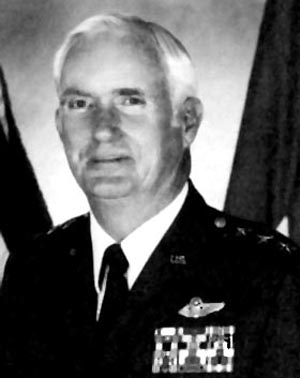
Lieutenant General E.G. "Buck" Shuler Jr. was commander of Strategic Air Command's Eighth Air Force in Barksdale Air Force Base, Louisiana. Eighth Air Force is responsible for Strategic Air Command operations in the eastern half of the United States, Europe and the Middle East. It comprises about half of SAC's long-range force of manned bombers, tankers and intercontinental ballistic missiles.

Harrison Lobdell Jr. was an American Air Force major general who was commandant, National War College, National Defense University, Fort Lesley J. McNair, Washington, D.C. from 1976 to 1978.

Lloyd Richardson Leavitt Jr. was an American Air Force lieutenant general. As vice commander in chief of the Strategic Air Command, Offutt Air Force Base, Nebraska, he fulfilled the responsibilities of the SAC commander in chief in his absence. He was also the commander's principal adviser in the formulation of SAC policies, plans, and directives.

Clarence Reuben Autery (1933–2010) was a major general in the United States Air Force. In 1979, he appeared in the docudrama First Strike, scenes of which were later edited into the television film The Day After. In both films, Autery is portrayed as a SAC commander who is airborne on a command plane during a nuclear attack by the Soviet Union. He was also interviewed about his role at SAC in Part One of the 1981 CBS News documentary series "The Defense Of The United States," which also used some of the "First Strike" footage.

Craven C. Rogers Jr. was a lieutenant general in the United States Air Force who served as deputy commander in chief of the U.S. Central Command at MacDill Air Force Base, Florida. The command was tasked with achieving United States national objectives in Southwest Asia, the Persian Gulf, and the Horn of Africa. Rogers was born in 1934, in Galveston, Texas. He earned a Bachelor of Science degree in engineering from the U.S. Military Academy in 1957 and a master's degree in business administration from The George Washington University. He completed Squadron Officer School in 1962 and the Industrial College of the Armed Forces in 1973. Upon graduation from the academy he was commissioned as a second lieutenant in the Air Force. After completing pilot training in September 1958 he was assigned to Tactical Air Command at Williams Air Force Base, Ariz., for gunnery training in the F-86F. With the phaseout of the F-86F, Rogers transferred in June 1959 as an instructor pilot to Air Training Command, Vance Air Force Base, Oklahoma. He completed F-101A transition training in September 1964 and then was assigned as a tactical fighter pilot with the 91st Tactical Fighter Squadron, Royal Air Force Station Bentwaters, England. In 1965 his squadron became the first unit in the United States Air Forces in Europe to transition to the F-4. Rogers assumed duties in the Standardization and Evaluation Section of the 81st Tactical Fighter Wing at Bentwaters in November 1966. In September 1967 he transferred to Nellis Air Force Base, Nevada, where he completed the F-4 Fighter Weapons School. In January 1968 he was assigned to the 557th Tactical Fighter Squadron, 12th Tactical Fighter Wing, Cam Ranh Bay Air Base, South Vietnam, as a flight commander and squadron weapons officer. He subsequently served as the wing weapons officer and assistant chief of weapons and tactics for 12th Tactical Fighter Wing. He flew 255 combat missions and 435 combat flying hours in the F-4C. He returned from Southeast Asia in February 1969 and was assigned to the Fighter and Reconnaissance Manning Section, Air Force Military Personnel Center, Randolph Air Force Base, Texas. He became chief of the section in 1971. Upon graduation from the Industrial College of the Armed Forces in August 1973, Rogers became deputy commander for operations, 1st Tactical Fighter Wing, MacDill Air Force Base, Florida. In June 1975 he transferred to Headquarters United States Air Force, Washington, D.C., as chief, Tactical Division, Directorate of Operational Requirements, Office of the Deputy Chief of Staff, Research and Development. In July 1977 Rogers was assigned as vice commander of the 4th Tactical Fighter Wing, Seymour Johnson Air Force Base, North Carolina. In June 1978 he became commander of the wing. He returned to Air Force headquarters in July 1980 and served as military assistant to the secretary of the Air Force. From June 1983 to July 1985 he was commander of United States Air Forces Korea; commander, United Nations Command Air Component; and commander, 314th Air Division, with headquarters at Osan Air Base, South Korea. He also was commander of the Korean Air Defense Sector, director of readiness and combat operations, and chief of staff of the Air Component Command/Combined Forces Command. Rogers then transferred to Hickam Air Force Base, Hawaii, as vice commander in chief, Pacific Air Forces. In December 1986 Rogers returned to Osan Air Base as commander, 7th Air Force; deputy commanding general, U.S. Forces Korea (Seoul); and deputy commander in chief, United Nations Command (Seoul). He is a command pilot with 5,200 flying hours. His military awards and decorations include the Defense Distinguished Service Medal with oak leaf cluster, Distinguished Service Medal, Legion of Merit with two oak leaf clusters, Distinguished Flying Cross with oak leaf cluster, Bronze Star Medal, Meritorious Service Medal with oak leaf cluster, Air Medal with 13 oak leaf clusters, Air Force Commendation Medal, Korean Order of National Security Merit (Chunsu) and Korean Order of National Security Merit (Kuksun). He was promoted to lieutenant general January 1, 1987, with same date of rank. He retired on April 1, 1991, and died on August 4, 2016.

George David Miller is a retired American Air Force lieutenant general whose last assignment was vice commander in chief, Strategic Air Command, headquartered at Offutt Air Force Base, Nebraska. He assumed this position September 1, 1981, and served until August 31, 1984.

William John Campbell was an American Air Force lieutenant general whose last assignment was vice commander in chief, Strategic Air Command, headquartered at Offutt Air Force Base, Nebraska. He assumed this position August 31, 1984 and served until July 26, 1985.

Robert Duane Beckel is a retired lieutenant general in the United States Air Force. He was the commander of the 15th Air Force at March Air Force Base, California.

Melbourne Kimsey was a brigadier general in the United States Air Force who served as director of the Cheyenne Mountain Complex from 1981 to 1983,



















